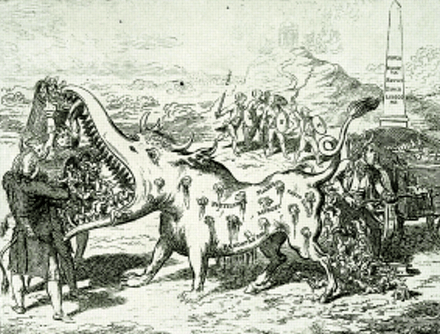| Box B: Anti-vaccination movements past and present
Anti-vaccination activity
Late 19th century—Anti-vaccinationists campaign against
smallpox vaccination, citing vaccine safety issues, vaccine failures,
infringement of personal liberty, and an unholy alliance between the
medical establishment and the government to reap huge profits for the
medical establishment at the expense of the public
Late 20th century—Anti-vaccinationists campaign against
vaccination, citing vaccine safety issues, vaccine failures,
infringement of personal liberty, and an unholy alliance between the
medical establishment and the government to reap huge profits for the
medical establishment at the expense of the public
Yes, vaccination continues purely due to financial
reasons.
"Vaccinations are now carried
out for purely commercial reasons because they fetch huge profits for
the pharmaceutical industry......There is no scientific evidence that
vaccinations are of any benefit, but it is clear that they cause a great
deal of harm...Today there are 800,000 children and youngsters under the
age of 15 years (Germany) with asthma. 800,000! Neurodermitis, once a
rare complaint, has become so common that there are several support
networks with many thousands of members. The 'Frankenpost' of April
2004 reported an estimated 27 million people now suffer from hayfever,
neurodermitis and allergic asthma in Germany."---Dr
Buchwald
(The Decline of Tuberculosis despite "Protective"
Vaccination by Dr. Gerhard Buchwald M.D. p130, 132, 134.)
Anti-vaccination literature
19th century—Anti-vaccinationists distribute information in a
wide variety of formats, including newspaper articles and letters,
books, journals, and pamphlets to warn against the dangers of
vaccination. Rarely into media. Media is
always pro-vaccine propagandist
20th century—Anti-vaccinationists distribute information in a
wide variety of formats, including newspaper articles and letters,
books, journals, and pamphlets to warn against the dangers of
vaccination
Anti-vaccinists VERY RARELY, if at all, get into the media.
It is always milder vaccine critics, but usually only vaccine reaction
stories by journalists.
"It is to this
indifference that I ascribe the fact that, with two or three exceptions,
all the London daily papers, morning and evening, ignored the
publication of the book altogether."---Arthur Hutton,
author of The vaccination Question 1895.
The only media investigation
into a childhood vaccine, of any note, was the Fresno Bee DPT vaccine
report of 1984.
No books ever gets into the
bookshops or public or school libraries. A recent search of the
Hereford county library system revealed NONE.
Anti-vaccination membership
19th century—Typical membership:1 4
1. Those who feel smallpox vaccination is ineffective
2. Persons who believed their relatives had suffered injury
or death due to vaccination
3. Persons opposed to compulsory vaccination as an
infringement of basic human rights
4. Proponents of alternative medical practice and theory,
especially homoeopaths. Herbalists, chiropractors, and
hydropaths
20th century—Typical membership:
1. Those who feel that some or all vaccinations are ineffective
or unsafe
2. Persons who believe their relatives had suffered injury or
death due to vaccination
3. Persons opposed to compulsory vaccination as an
infringement of basic human rights
4. Proponents of alternative medical practice and theory,
such as homoeopathy, herbal therapy, and chiropractic
also naturopathy. Anti-vax usually
follow the pleomorphic Bechamp disease theory which invalidates
vaccination.
Government hearings
19th century—The Royal Commission of the British Government
[1889-1896], investigating the grievances of the anti-vaccination
movement, hears testimony on vaccine safety and effectiveness from a
large number of anti-vaccinationists and pro-vaccinationists
20th century—The United States Congress [106th
Congress, 1999-2000] House Committee on Government Reform, investigating
the grievances of the anti-vaccination movement, hears testimony on
vaccine safety and effectiveness from a large number of anti-vaccinationists
and pro-vaccinationistsw1
Not true, most, if not all,
could be described as "vaccine critics", not "anti-vaccinists".
See
http://www.whale.to/v/burton1.html
"Anti-vaccine" has become a pejorative term, so few would want to be
described as that, even if they were.
Medical establishment response to anti-vaccinationists
19th century—Fearing the outbreak of new epidemics due to a
drop in vaccine uptake (smallpox), medical authorities call for stronger
efforts to increase vaccination rates
20th century— Fearing the outbreak of new epidemics due to a
drop in vaccine uptake (pertussis, measles), medical authorities call
for stronger efforts to increase vaccination rates
Effects of anti-vaccination ideas
19th century—Anti-vaccination activity leads to drop of
smallpox vaccination rate in Stockholm, Sweden to just over 40% of the
population by 1872 (uptake approached 90% elsewhere in Sweden). Epidemic
in Stockholm in 1874 leads to rise in vaccine uptake and an end of major
smallpox epidemics in Sweden7
Utter drivel. See the
vaccine failure
http://www.whale.to/vaccine/smallpox3.html
In England, compulsory vaccination against
smallpox was first introduced in 1852, yet in the period 1857 to 1859, a
smallpox epidemic killed 14,244 people. In 1863 to 1865, a second
epidemic claimed 20,059 lives. In 1867, a more stringent compulsory
vaccination law was passed and those who evaded vaccination were
prosecuted. After an intensive tour year effort to vaccinate the entire
population between the ages of 2 - 50, the Chief Medical Officer of
England announced in May 1871 that 97.5% had been vaccinated. In the
following year, 1872, England experienced its worst ever smallpox
epidemic which claimed 44,840 lives. Between 1871-1880, during the
period of compulsory vaccination, the death rate from smallpox leapt
from 28 to 46 per 100,000 population.
20th century—Anti-vaccination activity, raising concerns over
vaccine safety, leads to drop in pertussis vaccine uptake in United
Kingdom from 81% in late 1960s to 31% by mid-1970s. Pertussis epidemics
followed; rise in uptake to 93% ends epidemics w2
All vaccine success stories
end up full of holes, when you look into it. |
 using
vaccination in its wider sense of "any immunisation"
using
vaccination in its wider sense of "any immunisation"
 Two
boxes appear on bmj.com
Two
boxes appear on bmj.com